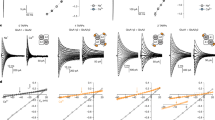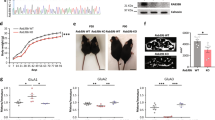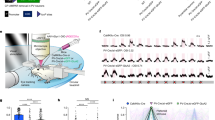Abstract
Withdrawal from prescribed opioids results in increased pain sensitivity, which prolongs the treatment. This pain sensitivity is attributed to neuroplastic changes that converge at the spinal cord dorsal horn. We have recently reported that repeated morphine administration triggers an insertion of GluA2-lacking (Ca2+-permeable) α-amino-3-hydroxy-5-methyl-4-isoxazole propionic acid receptors (AMPAR) in the hippocampus. This finding together with the reported involvement of AMPAR in the mechanisms underlying inflammatory pain led us to hypothesize a role for spinal AMPAR in opioid-induced pain behavior. Mice treated with escalating doses of morphine showed hypersensitivity to mechanical stimulation. Intrathecal administration of a Ca2+-permeable AMPAR selective blocker disrupted morphine-induced mechanical sensitivity. Analysis of the expression and phosphorylation levels of AMPAR subunits (GluA1/2/3/4) in homogenates and in postsynaptic density fractions from spinal cord dorsal horns showed an increase in GluA4 expression and phosphorylation in the postsynaptic density after morphine. Co-immunoprecipitation analyses suggested an increase in GluA4 homomers (Ca2+-permeable AMPAR) and immunohistochemical staining localized the increase in GluA4 levels in laminae III–V. The excitatory postsynaptic currents (EPSCs) recorded in laminae III–V showed enhanced sensitivity to Ca2+-permeable AMPAR blockers in morphine-treated mice. Furthermore, current–voltage relationships of AMPAR-mediated EPSCs showed that rectification index (an indicator of Ca2+-permeable AMPAR contribution) is increased in morphine-treated but not in saline-treated mice. These effects could be reversed by infusion of GluA4 antibody through patch pipette. This is the first direct evidence for a role of GluA4-containing AMPAR in morphine-induced pain and highlights spinal GluA4-containing AMPAR as targets to prevent the morphine-induced pain sensitivity.
Similar content being viewed by others
Log in or create a free account to read this content
Gain free access to this article, as well as selected content from this journal and more on nature.com
or
References
Angst MS, Clark JD (2006). Opioid-induced hyperalgesia: a qualitative systematic review. Anesthesiology 104: 570–587.
Atianjoh FE, Yaster M, Zhao X, Takamiya K, Xia J, Gauda EB et al (2010). Spinal cord protein interacting with C kinase 1 is required for the maintenance of complete Freund’s adjuvant-induced inflammatory pain but not for incision-induced post-operative pain. Pain 151: 226–234.
Billa SK, Liu J, Bjorklund NL, Sinha N, Fu Y, Shinnick-Gallagher P et al (2010). Increased insertion of glutamate receptor 2-lacking alpha-amino-3-hydroxy-5-methyl-4-isoxazole propionic acid (AMPA) receptors at hippocampal synapses upon repeated morphine administration. Mol Pharmacol 77: 874–883.
Boehm J, Malinow R (2005). AMPA receptor phosphorylation during synaptic plasticity. Biochem Soc Trans 33: 1354–1356.
Buldakova SL, Kim KK, Tikhonov DB, Magazanik LG (2007). Selective blockade of Ca2+ permeable AMPA receptors in CA1 area of rat hippocampus. Neuroscience 144: 88–99.
Cabañero D, Campillo A, Célérier E, Romero A, Puig MM (2009). Pronociceptive effects of remifentanil in a mouse model of postsurgical pain: effect of a second surgery. Anesthesiology 111: 1334–1345.
Carlton SM, Du J, Tan HY, Nesic O, Hargett GL, Bopp AC et al (2009). Peripheral and central sensitization in remote spinal cord regions contribute to central neuropathic pain after spinal cord injury. Pain 147: 265–276.
Célérier E, Simonnet G, Maldonado R (2004). Prevention of fentanyl-induced delayed pronociceptive effects in mice lacking the protein kinase Cgamma gene. Neuropharmacology 46: 264–272.
Chakrabarti S, Regec A, Gintzler AR (2005). Chronic morphine acts via a protein kinase Cgamma-G(beta)-adenylyl cyclase complex to augment phosphorylation of G(beta) and G(betagamma) stimulatory adenylyl cyclase signaling. Brain Res Mol Brain Res 138: 94–103.
Chaplan SR, Bach FW, Pogrel JW, Chung JM, Yaksh TL (1994). Quantitative assessment of tactile allodynia in the rat paw. J Neurosci Methods 53: 55–63.
Chu LF, Clark DJ, Angst MS (2006). Opioid tolerance and hyperalgesia in chronic pain patients after one month of oral morphine therapy: a preliminary prospective study. J Pain 7: 43–48.
Crofford LJ (2010). Adverse effects of chronic opioid therapy for chronic musculoskeletal pain. Nat Rev Rheumatol 6: 191–197.
Drdla R, Gassner M, Gingl E, Sandkuhler J (2009). Induction of synaptic long-term potentiation after opioid withdrawal. Science 325: 207–210.
Esteban JA, Shi SH, Wilson C, Nuriya M, Huganir RL, Malinow R (2003). PKA phosphorylation of AMPA receptor subunits controls synaptic trafficking underlying plasticity. Nat Neurosci 6: 136–143.
Gangadharan V, Wang R, Ulzhofer B, Luo C, Bardoni R, Bali KK et al (2011). Peripheral calcium-permeable AMPA receptors regulate chronic inflammatory pain in mice. J Clin Invest 121: 1608–1623.
Gendron L, Esdaile MJ, Mennicken F, Pan H, O'Donnell D, Vincent JP et al (2007). Morphine priming in rats with chronic inflammation reveals a dichotomy between antihyperalgesic and antinociceptive properties of deltorphin. Neuroscience 144: 263–274.
Gomes AR, Correia SS, Esteban JA, Duarte CB, Carvalho AL (2007). PKC anchoring to GluR4 AMPA receptor subunit modulates PKC-driven receptor phosphorylation and surface expression. Traffic 8: 259–269.
Hay JL, White JM, Bochner F, Somogyi AA, Semple TJ, Rounsefell B (2009). Hyperalgesia in opioid-managed chronic pain and opioid-dependent patients. J Pain 10: 316–322.
Kopach O, Kao SC, Petralia RS, Belan P, Tao YX, Voitenko N (2011). Inflammation alters trafficking of extrasynaptic AMPA receptors in tonically firing lamina II neurons of the rat spinal dorsal horn. Pain 152: 912–923.
Latremoliere A, Woolf CJ (2009). Central sensitization: a generator of pain hypersensitivity by central neural plasticity. J Pain 10: 895–926.
Le Bars D, Gozariu M, Cadden SW (2001). Animal models of nociception. Pharmacol Rev 53: 597–652.
Liang D, Shi X, Qiao Y, Angst MS, Yeomans DC, Clark JD (2008). Chronic morphine administration enhances nociceptive sensitivity and local cytokine production after incision. Mol Pain 4: 7.
Liang DY, Li X, Clark JD (2011). 5-Hydroxytryptamine Type 3 Receptor Modulates Opioid-induced Hyperalgesia and Tolerance in Mice. Anesthesiology 114: 1180–1189.
Malinow R, Malenka RC (2002). AMPA receptor trafficking and synaptic plasticity. Annu Rev Neurosci 25: 103–126.
Man HY, Sekine-Aizawa Y, Huganir RL (2007). Regulation of {alpha}-amino-3-hydroxy-5-methyl-4-isoxazolepropionic acid receptor trafficking through PKA phosphorylation of the Glu receptor 1 subunit. Proc Natl Acad Sci USA 104: 3579–3584.
Moron JA, Abul-Husn NS, Rozenfeld R, Dolios G, Wang R, Devi LA (2007). Morphine administration alters the profile of hippocampal postsynaptic density-associated proteins: a proteomics study focusing on endocytic proteins. Mol Cell Proteomics 6: 29–42.
Muscoli C, Doyle T, Dagostino C, Bryant L, Chen Z, Watkins LR et al (2010). Counter-regulation of opioid analgesia by glial-derived bioactive sphingolipids. J Neurosci 30: 15400–15408.
Nagy GG, Al-Ayyan M, Andrew D, Fukaya M, Watanabe M, Todd AJ (2004). Widespread expression of the AMPA receptor GluR2 subunit at glutamatergic synapses in the rat spinal cord and phosphorylation of GluR1 in response to noxious stimulation revealed with an antigen-unmasking method. J Neurosci 24: 5766–5777.
Narita M, Mizoguchi H, Nagase H, Suzuki T, Tseng LF (2001). Involvement of spinal protein kinase Cgamma in the attenuation of opioid mu-receptor-mediated G-protein activation after chronic intrathecal administration of [D-Ala2,N-MePhe4,Gly-Ol(5)]enkephalin. J Neurosci 21: 3715–3720.
Okabe S, Miwa A, Okado H (2001). Spine formation and correlated assembly of presynaptic and postsynaptic molecules. J Neurosci 21: 6105–6114.
Park JS, Voitenko N, Petralia RS, Guan X, Xu JT, Steinberg JP et al (2009). Persistent inflammation induces GluR2 internalization via NMDA receptor-triggered PKC activation in dorsal horn neurons. J Neurosci 29: 3206–3219.
Polgar E, Al-Khater KM, Shehab S, Watanabe M, Todd AJ (2008a). Large projection neurons in lamina I of the rat spinal cord that lack the neurokinin 1 receptor are densely innervated by VGLUT2-containing axons and possess GluR4-containing AMPA receptors. J Neurosci 28: 13150–13160.
Polgar E, Watanabe M, Hartmann B, Grant SG, Todd AJ (2008b). Expression of AMPA receptor subunits at synapses in laminae I-III of the rodent spinal dorsal horn. Mol Pain 4: 5.
Polgar E, Wright LL, Todd AJ (2010). A quantitative study of brainstem projections from lamina I neurons in the cervical and lumbar enlargement of the rat. Brain Res 1308: 58–67.
Todd AJ, Polgar E, Watt C, Bailey ME, Watanabe M (2009). Neurokinin 1 receptor-expressing projection neurons in laminae III and IV of the rat spinal cord have synaptic AMPA receptors that contain GluR2, GluR3 and GluR4 subunits. Eur J Neurosci 29: 718–726.
Tong CK, MacDermott AB (2006). Both Ca2+-permeable and -impermeable AMPA receptors contribute to primary synaptic drive onto rat dorsal horn neurons. J Physiol 575: 133–144.
Tumati S, Roeske WR, Largent-Milnes TM, Vanderah TW, Varga EV (2011). Intrathecal PKA-selective siRNA treatment blocks sustained morphine-mediated pain sensitization and antinociceptive tolerance in rats. J Neurosci Methods 199: 62–68.
Vera-Portocarrero LP, Zhang ET, King T, Ossipov MH, Vanderah TW, Lai J et al (2007). Spinal NK-1 receptor expressing neurons mediate opioid-induced hyperalgesia and antinociceptive tolerance via activation of descending pathways. Pain 129: 35–45.
Xia Y, Portugal GS, Fakira AK, Melyan Z, Neve R, Lee HT et al (2011). Hippocampal GluA1-containing AMPA receptors mediate context-dependent sensitization to morphine. J Neurosci 31: 16279–16291.
Youn DH, Royle G, Kolaj M, Vissel B, Randic M (2008). Enhanced LTP of primary afferent neurotransmission in AMPA receptor GluR2-deficient mice. Pain 136: 158–167.
Zheng Z, Keifer J (2008). Protein kinase C-dependent and independent signaling pathways regulate synaptic GluR1 and GluR4 AMPAR subunits during in vitro classical conditioning. Neuroscience 156: 872–884.
Zimmermann M (1983). Ethical guidelines for investigations of experimental pain in conscious animals. Pain 16: 109–110.
Acknowledgements
This work was supported by NIH grants DA027460 (J.A.M., S.M.C) and DA025036 (J.A.M). We thank Dr Leonardo Pignataro for the generous gift of Synaptophysin-I antibody, Drs Amy B MacDermott and Chi-Kun Tong for the help with the spinal cord slice preparation technique, and Dr Jie Liu for sharing his laboratory equipment and technical expertise.
Author information
Authors and Affiliations
Corresponding author
Ethics declarations
Competing interests
The authors declare no conflict of interest.
Rights and permissions
About this article
Cite this article
Cabañero, D., Baker, A., Zhou, S. et al. Pain after Discontinuation of Morphine Treatment Is Associated with Synaptic Increase of GluA4-Containing AMPAR in the Dorsal Horn of the Spinal Cord. Neuropsychopharmacol 38, 1472–1484 (2013). https://doi.org/10.1038/npp.2013.46
Received:
Revised:
Accepted:
Published:
Issue date:
DOI: https://doi.org/10.1038/npp.2013.46
Keywords
This article is cited by
-
Glioma synapses recruit mechanisms of adaptive plasticity
Nature (2023)
-
Search for Selective Glua1 Ampa Receptor Antagonists in a Series of Dicationic Compounds
Pharmaceutical Chemistry Journal (2022)
-
Vezatin regulates seizures by controlling AMPAR-mediated synaptic activity
Cell Death & Disease (2021)



